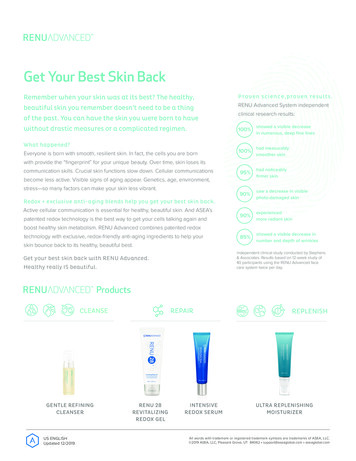
Transcription
Acta Derm Venereol 2013; 93: 261–267REVIEW ARTICLESkin pH: From Basic Science to Basic Skin CareSaba M. Ali and Gil YosipovitchDepartment of Dermatology, Wake Forest University Baptist Medical Center, Winston-Salem, USAThe “acid mantle” is a topic not only of historical interest, but also of clinical significance and has recentlybeen linked to vital stratum corneum function. Despitecompelling basic science evidence placing skin pH asa key factor in barrier homeostasis, stratum corneumintegrity, and antimicrobial defense, application of theacid mantle concept in clinical care is lacking. We reviewrecent basic science investigations into skin pH, discussskin disorders characterized by aberrant pH, and finallydiscuss practical application for preservation of the acidmantle. Recognizing factors that alter skin pH and selecting products that preserve the acid mantle is of primeimportance in treating dermatologic patients. Key words:skin pH; acid mantle; stratum corneum; barrier homeostasis; serine protease; atopic dermatitis; acne; intertrigo;diaper dermatitis; syndets.Accepted Nov 12, 2012; Epub ahead of print Jan 16, 2013Acta Derm Venereol 2013; 93: 261–267.Prof. Gil Yosipovitch, Department of Dermatology,Wake Forest University Health Sciences, Medical CenterBoulevard, Winston-Salem, NC 27157, USA. E-mail:gyosipov@wfubmc.eduNearly a century ago, Schade and Marchionini first coinedthe term Säuremantel or “acid mantle” to describe theinherent acidic nature of the stratum corneum (SC) (1).In the last decade it has been demonstrated that skin pHlargely influences barrier homeostasis, SC integrity andcohesion, and antimicrobial defense mechanisms (2–7).In spite of mounting evidence that skin pH playsa vital role in SC function, application of the “acidmantle” concept in clinical care has lagged behind. Theimportance of preserving an acidic skin pH, especiallyin those affected by certain skin diseases, remains anunder-recognized topic by practicing U.S dermatologists. This is evident by the scarcity of low pH soaps,cleansers, and moisturizers available in the US market.The purpose of this article is to reintroduce the subjectof the “acid mantle” and provide the reader with objective evidence that skin pH is intimately linked to vitalSC function. It is impossible to ignore recent compelling basic science investigations placing the role of pHin the forefront of SC function (2–6). Aberrant pH hasbeen noted in several skin diseases and these will bereviewed. Finally, practical recommendations will be 2013 The Authors. doi: 10.2340/00015555-1531Journal Compilation 2013 Acta Dermato-Venereologica. ISSN 0001-5555discussed with respect to use of soaps, cleansers, andmoisturizers that preserve the “acid mantle”. At the veryleast, we hope to provide some “pH” ood for thought.Physiologic skin pHSkin pH is normally acidic, ranging in pH values of4–6, while the body’s internal environment maintains anear-neutral pH (7–9). This creates a steep pH gradientof 2–3 units between the SC and underlying epidermisand dermis. The physiologic role of an acidic skin surface, historically was thought to be a defense mechanism against invading organisms. More recently, it hasbeen demonstrated that several key enzymes involvedin the synthesis and maintenance of a competent skinbarrier are largely impacted by pH. Hence, a broaderview of the importance of pH in relation to functionand integrity of the skin is emerging.Factors influencing skin pHA number of factors, including both endogenous andexogenous elements, affect skin pH. See Table I (10).Some of these endogenous factors will be discussed,and altered pH observed in these situations may partially explain certain clinical phenomena observed inthese settings.AgeImmediately after birth, skin surface pH of both fullterm and preterm neonates is elevated compared toadults and older children. The mean pH value from 6different body sites in the first day of life in full-termneonates was 7.08, which is significantly higher thanin adult controls (pH 5.7) (11). pH decreases steeply inthe first few days of the postnatal period and then moreTable I. Factors influencing skin pH (adopted from Yosipovitchet al. 1996 (10))Endogenous factorsExogenous factorsAgeAnatomic siteGenetic predispositionEthnic differencesSebumSkin moistureSweatDetergents, cosmetics, soapsOcclusive dressingsSkin irritantsTopical antibacterialsActa Derm Venereol 93
2S. M. Ali and G. Yosipovitchgradually in the rest of the neonatal period (12–14). pHvalues later in infancy are similar to that of adults (15).A decrease in pH occurs from day 3 to day 30 of theneonatal period and is most prominent in the volar forearm area compared with the forehead, cheeks, and buttocks (14). There is no disparity in pH values between different body sites in the neonate 1–2 days after birth (11).By day 90, pH is higher on the cheek and buttock andlower on the forehead and forearm (14). This apparentdifference can be explained by exogenous factors, namelydiaper occlusion in the buttock region and climatic factorsin the exposed cheek skin (16). Eczema generally favorsextensor areas in neonates, i.e. the cheeks, compared tothe usual flexural distribution in adults. Extensor eczemaand diaper dermatitis, commonly observed dermatoses inthe infant, arise in areas with higher pH values.A potential mechanism associated with enhanced desquamation observed in the first few days postpartum relates to the elevated pH levels. Elevated pH is known toincrease activity of serine proteases, kallikrein 5 and 7,which are involved in desquamation and degradation ofcorneodesmosomes (5). Increased activity of these enzymes in the setting of higher pH levels likely explains theenhanced desquamation observed in the first few dayspostpartum, when the skin surface is more alkaline (16).Additionally, key enzymes involved in the synthesisof the permeability barrier, β-glucocerebrosidase andacidic sphingomyelinase, which require an acidic pHare not fully activated in the newborn period resultingin decreased skin hydration (17).Increased skin pH and reduced buffer capacity hasalso been documented in skin of the elderly (9, 18, 19).Ceramide deficiency, observed in aged skin (20) hasimplications for barrier function and may be explainedby elevated activity levels of certain enzymes that havealkaline optima. Alkaline ceramidase, which has a pHoptimum of 9 and is involved in barrier lipid degradation, has higher activity in aged human skin (7).Skin siteThere are “physiologic gaps” in the acid barrier depending on skin site, particularly the interdigital spaces andintertriginous areas-axillae, groin, inframammary zone.The pH is higher in these regions compared to other skinsites (21). Higher pH in the axilla leads to colonizationby certain odor-producing resident bacteria such as propionibacteria and staphylococci (22). Deodorants containing citrates reduce pH and inhibit bacterial activity(23). Candidal intertrigo also preferentially developsin the alkaline environment of the intertriginous areas.Pigmented skinGunathilake et al. (4) demonstrated significantly moreacidic surface pH in darkly pigmented individuals(Fitzpatrick IV–V) compared to lightly pigmentedActa Derm Venereol 93subjects (Fitzpatrick I–II) (pH 4.6 0.03 vs. 5.0 0.04).Additionally, superior SC integrity and barrier func tion were observed in darker skin. These qualitieswere attributed to increased epidermal lipid content,increased lamellar body density, and lower pH in thedarkly pigmented group. Serine protease activity wasreduced in the more acidic environment of the darkerskinned group and increased in the higher pH settingof the lightly pigmented group. Furthermore, acidification of type I–II skin with topical polyhydroxyl acidsto pH levels seen in type IV–V skin enhanced barrierfunction in the former group to levels comparable tothe darkly pigmented group (4).Skin ph and barrier functionThe stratum corneum’s role as a permeability barrierhinges on its hydrophobic character, lipid distribution, and organization of lipids into a series of lamellar bilayers (24). The formation of the SC barrier,specifically generation of its lipophilic components,involves several pH-dependent enzymes. Two keylipid-processing enzymes, β-glucocerebrosidase andacidic sphingomyelinase have pH optima of 5.6 and4.5, respectively (7). Both are involved in the synthesisof ceramides, critical components of the permeabilitybarrier. Activity of β-glucocererbrosidase is 10 timeslower in situ at pH 7.4 than at pH 5.5 (25). Processingof lipids secreted by lamellar bodies and formation oflamellar structures require an acidic environment (26).Additionally, free fatty acids in the extracellular spaceform lamellar liquid crystals at pH values of 4.5–6through partial ionization (26–28).Investigations in both mice and human models corroborate the assertion that pH impacts barrier function.In vivo studies in hairless mice exposed to acetone insultor adhesive film-stripping demonstrated faster barrierfunction recovery in the presence of acidic buffer solution compared to neutral buffer solution (25). Similarly,blockade or knockout of secretory phosholipase A2 orthe sodium-proton exchanger, both of which are involved in acidification of the SC, resulted in compromisedpermeability barrier homeostasis and SC integrity (2,3). Finally, studies have shown that elevations of pHin normal skin creates a disturbed barrier, linked toincreased activity of serine proteases and reduced activities of ceramide-generating enzymes (5, 6).Recently, Hatano et al. (29) demonstrated that maintenance of an acidic SC via application of polyhydroxylacids prevented development of hapten-induced atopicdermatitis (AD) in at-risk mice. Lowering pH in thesehapten exposed mice also reduced the inflammatoryTH2 response, prevented epidermal hyperplasia, reduced tissue eosinophilia, and normalized epidermal structure (29). Their findings provide intriguing implicationsabout the use of acidic topical preparations in altering
Skin pH: Basic science to basic skin carethe course of inflammatory dermatoses. Applications ofpolyhydroxyl acids have been shown in earlier studiesto improve barrier function in both neonatal and agedrodent skin (30, 31) and even to super-normalize barrier function in normal mice (32), and in humans (4).Skin pH and stratum corneum integritypH not only influences barrier homeostasis, but alsoaffects SC integrity, cohesion, and desquamation. Serine proteases, kallikrein 5 (SC tryptic enzyme) andkallikrein 7 (SC chymotryptic enzyme), have neutralpH optima and are intimately linked to desquamationby degrading desmoglein 1 (33–35). As pH increases,these serine proteases are activated, while the enzymes responsible for generating ceramides which havean acidic optima are inactivated compromising SCstructure and function. As serine protease activity issustained, lamellar body secretion is blocked (6, 36).See Fig. 1 for summary.Skin pH and antimicrobial propertiesThe microflora of the skin consists of transient,temporary-resident, and permanent-resident species,including coagulase-negative staphylococci (37).Normal flora growth is optimal at acidic pH levels,whereas pathogenic bacteria, such as S. aureus, thriveat a neutral pH levels (38). Dermicidin, an antimicrobialpeptide found in sweat, demonstrates antimicrobial activity against a variety of pathogenic microorganisms.Incubation of S. aureus with a sweat fraction containingdermicidin induced 90% bacteriocidal effect whenbuffered at pH 5.5, and only 60% when buffered atpH 6.5 (39). Chikakane & Takashashi (40) have alsopostulated reduced antibacterial activities of cationicsubstances, such as certain basic proteins, due to reduced acidity. Nitrate secreted in sweat is converted tonitrite by bacteria. Nitrite then forms reactive nitrogenspecies which serve as a non-specific antibacterial defense mechanism. This occurs in an acidic milieu (41).Skin pH in diseasePermeability barrier homeostasis when functioningproperly imparts the skin with the capability of withstanding external insults and retaining hydration.Stratum corneum pH and permeability homeostasis areco-dependent as earlier described. Several dermatosesSP activitypHDSG degradationloss of corneodesmosomesβ-Glcer’ase / sphingomyelinase activity3characterized by disruption of the permeability barrierhave altered pH and these will be discussed.Atopic dermatitisIn a study of 100 children with AD, pH was observedto be significantly higher in eczematous skin and uninvolved skin in comparison to the skin of 21 healthychildren (42). Others have documented similar findingsof sequentially rising pH values in unaffected skincompared to perilesional skin and lesional skin in atopicpatients (43, 44). Additionally, higher pH values havebeen measured in areas corresponding to more intenseitching (44) and skin dryness in atopics (43).Why is pH altered in atopic skin? Several contributing factors have been proposed. Free amino acids andurocanic acid, which are believed to be involved in creating the acidic milieu of the SC, are markedly reducedin atopic skin (45, 46). Filaggrin, a protein known tobe deficient in AD, serves as an important precursor offree amino acids and urocanic acid. Sweat secretions,rich in lactic acid, also thought to contribute to the acidmantle, are reduced in AD (47). Finally, faulty secretionof lamellar bodies seen in AD (48), may have implications on acid pH, as exocytosis of lamellar bodies is asource of protons for SC acidification (49).Impaired barrier function in AD can be explained inpart by disturbed synthesis, excretion, and maturationof SC lipids (48, 49) processes that depend on enzymeswith acidic pH optima. Aberrant lipid organization,namely increased gel phase relative to the crystallinephase of lamellar structures, has been described ex vivoin patients with AD (50). Lamellar liquid crystal formation occurs at pH values of 4.5–6. Serine proteases,specifically SC chymotryptic enzyme which has a pHoptimum of 8 may also play a role in the pathogenesisof AD. Transgenic mice with increased serine proteaseactivity exhibit an AD-like presentation (51). SC chymotryptic enzyme expression is dramatically increasedin chronic eczema lesions (51). (Fig. 2). Moreover,serine proteases induce itch by activating PAR-2 receptors in keratinocytes and nerves in atopic skin furtherdamaging the skin by inducing an itch scratch cycle (52).In addition to impaired barrier, S. aureus colonization is a common feature of patients with AD and isconsidered a major pathogenetic factor in AD. Growthof staphylococcal strains is maximal at neutral pH (53)and markedly inhibited at pH values around 5 (53, 54).The 3 dimensional structure of Staphy lococci entertoxins is affected by pH. Staphylococci enterotoxin C2has been shown to largely deviate from its normal 3-Dabnormal integrity/cohesionlipid processingabnormal permeability homeostasisFig. 1. Mechanism of pHaltering permeability andstratum corneum integrity.SP: serine protease DSG:desmoglein.Acta Derm Venereol 93
S. M. Ali and G. Yosipovitch4and alteration in pH disturbs normal desquamation (57).The use of acidic preparations with lactic acid promoteskeratolysis and is effective in these ichthyoses.Candidal intertrigostructure at pH 5 compared to pH of 8 (55). In vitro, theadhesion of S. aureus to human keratinocytes increasedwith increasing pH (56). See Fig. 3 for summary of pHrelated events in AD.Candida albicans, a dimorphic yeast, is influenced bypH. An acidic pH favors the blastospore form and anincreased pH promotes the mycelial phase (58, 59).The mycelial form is associated with pathogenicity (58,60). In one study (61), solution with C. albicans wasapplied under occlusion to the left and right forearmsof subjects, buffered at 2 different pH levels (6.0 and4.5). Skin reactions 24 h later were more pronouncedon the arm with the higher pH in 14 of the 15 subjectsstudied. An acidified nitrite cream has been reportedto have antimycotic activity (62). Diabetics are particularly prone to develop candidal intertrigo. In a studyinvolving non-insulin dependent diabetics, skin pHwas significantly higher in the intertriginous zones ofdiabetics compared to intertriginous zones of healthyindividuals (63). Interestingly, there was no differencein forearm pH of the two groups. Higher pH in diabeticintertriginous skin was interpreted as a possible factorpromoting host susceptibility to candidal infection.IchthyosisDiaper dermatitisFig. 2. Increased serine protease activity in atopic dermatitis (top) comparedto normal (bottom). Orange fluorescence correlates to serine protease activity.Contributed by Dr. Peter Elias (unpublishd data).Öhman & Vahlquist (57), found significantly higherskin pH (5.3 0.7) in patients with ichthyosis vulgariscompared to patients with X-linked ichthyosis (4.6 0.4)and healthy subjects (4.5 0.2). During tape stripping,a neutral pH of about 7 was reached in patients withichthyosis vulgaris after half the horny layer was removed. In X-linked ichthyosis, a plateau of 6.2–6.6in pH value was never exceeded with tape stripping.Filaggrin is known to be reduced in ichthyosis vulgaris and is also believed to play a role in acidifying theSC. Conversely, in X-linked ichthyosis, the aberrationinvolves steroid sulphatase leading to accumulation ofcholesterol sulphate and flattening of the pH gradient.Enzymes involved in desquamation are pH-dependentConsequences of pH in Atopic DermatitisBoth Acquired Stressors& ationCorneodesmosomesLamellar BodySecretion-Glucocerebrosidase,Acid SphingomyelinaseCeramidesFig. 3. Relation of skin pH in atopic dermatitis.Acta Derm Venereol 93InflammationSCCohesionPermeabilityBarrierA number of factors play a role in development of irritant diaper dermatitis, including prolonged exposureto urine and feces, increased hydration and occlusion,changes in skin microbial flora, and altered skin pH(64). Significant correlation between severity of diaperdermatitis and elevated skin pH in the diaper area hasbeen demonstrated (65). Exposure of urine and fecesgenerates ammonia and produces an alkaline environment. Alkaline pH activates fecal proteases andlipases which breakdown the skin barrier. Elevated pHalso influences susceptibility to C. albicans as earlierdescribed, and C. albicans is the microorganism mostcommonly associated with diaper dermatitis. Recently,Beguin et al. (66) designed an adult diaper using acidiccellulose material in order to maintain a pH of 4.5–5.5in the diaper area. Resolution of pre-existing irritantskin lesions was noted in 8 out of 12 patients afterswitching to the acidified diaper design (66). Development of cleansing wipes with increased pH bufferingcapacity to maintain physiologic skin pH has recentlybeen under investigation (67).Also, tampons that are purported to reduce the usualrise in vaginal pH during menstruation have been developed and are available for purchase. Vaginal pHin healthy, pre-menopausal women ranges between3.5–4.5. The pH of blood is 7.4 and during menstruationvaginal pH increases. RepHresh Brilliant pH tamponsare currently available and employ a pH-Reducing Micro Ribbon and contain citric acid and L-lactide (68).
Skin pH: Basic science to basic skin careIrritant contact dermatitisIndividuals prone to irritant contact dermatitis havebeen shown to have higher pH values compared tohealthy individuals (69, 70). pH induced decline in SCintegrity and barrier homeostasis further compounds theskin’s susceptibility to injury from exposure to solvents,detergents, and mechanical forces (5).Tinea pedisIn one study, mean skin pH values from the foot regionof subjects with tinea pedis and those without tineapedis were compared. Foot skin pH was significantlyhigher in patients with tinea compared to controls (40).AcneIn vitro, P. acnes grows well at pH values between 6and 6.5 and growth is markedly reduced at pH valuesless than 6 (71). In a study of acne-prone patients, thenumber of facial inflammatory lesions was comparedin subjects using a conventional alkaline soap versusthose using an acidic syndet bar. The number of inflammatory lesions increased in the alkaline soap groupand decreased in the group using the acidic syndet atstatistically significant levels by the 4th week of application (72).UremicsSkin surface pH has been shown to be significantlyhigher in patients on dialysis compared to healthyindividuals (73), despite the fact that dialysis patientshave chronic acidemia. Cutaneous infections, primarilyfungal infections are common in patients on hemodialysis (74). The high pH may predispose this patientpopulation to increased mycotic infections and maysuggest a possible role in uremic pruritus (73).Practical applicationIt has been suggested that altered pH observed in thevarious dermatoses described earlier, is a “meaningfuletiological component” and not merely an “epiphenomenon” of these conditions (75). Exposure to exogenous agents such as cleansers, creams, deodorants, andtopical antibacterials affect pH and can further exacerbate underlying disease in these patients. Selectionof topical agents that preserve an acidic environmentseems relevant in these patients.CleansersCleansers can be classified according to the type ofsurfactant used. Cleansers with non-soap-based surfactants are known as “syndets” (synthetic detergent-basedbars or liquids). Syndets are generally neutral or acidic5( pH 7) compared to soap-based cleansers which aretypically alkaline in nature (pH 10) (76). Soap-basedcleansers are known to have a higher potential to irritate skin than syndets (77–82). Ananthapadmanabhanand colleagues (83) have demonstrated that high-pHsolutions even in the absence of surfactants increaseSC swelling and lipid rigidity. The higher pH of soapbars may be a contributing factor in the higher irritationpotential of soap bars compared to syndet bars. Handwashing with soap causes the pH on the palms to increase by a mean of 3 units and remains altered 90 minafter washing (7). Small and sustained pH increases,like those caused by daily use of soap-based cleansersmultiple times a day, adversely influence the barrierrepair mechanism (3). Baranda et al. (84) measuredthe pH of common cleansers (Table II). They found asignificant correlation between alkaline pH of cleansersand skin irritation. In addition to information on pHof common cleansers, information regarding availablelow pH moisturizers is not readily accessible. Shi et al.(85) recently measured the pH of several moisturizerscommonly used in the US some of which were foundto have quite high alkaline pH (Table SI; availablefrom http://www.medicaljournals.se/acta/content/?doi 10.2340/00015555-1531).Acidification of the stratum corneumTopical alpha-hydroxy acids (AHA) are common agentsused in treating disorders of keratinization. AHA, suchas lactic acid have been shown to increase ceramideTable II. pH of cleansers (Adopted from Baranda et al. (84))Brand namepHCompositionAdermAvecydeAvéneCetaphilDove whiteDove babyDove (liquid)Dove pinkJohnson’s babyJohnson’s baby oatNivea baby creamyNivea bath careNivea bath c. AlmondNivea bath c. OatZest neutralZest citrus sportZest herbalZest aquaPalmolive greenPalmolive (white)Palmolive botanicalsPalmolive botanicals/camomileCamay classicCamay galaCamay oapSoapSoapSoapSoapSoapSoapSoapSoapSoapSoapplus mineral oil.aActa Derm Venereol 93
6S. M. Ali and G. Yosipovitchproduction by human keratinocytes by 300% in vitro(86). In one study, twice daily application of 4% l-lacticacid formulations (pH 3.7–4.0) led to significant improvement in barrier function as measured by TEWLand reduced sensitivity to sodium lauryl sulphate (SLS)after 4 weeks (86). In vivo the total ceramide fractionincreased significantly. The ability of AHA to increaseceramide levels is beneficial in those individuals withreduced barrier function such as atopics who havereduced levels of ceramides (87, 88). Studies haveshown beneficial effects of topical acidic electrolytewater (pH 2.0–2.7) on the severity of dermatitis andS. aureus colonization of the skin in children (89) andadults (90). Use of AHA in irritant dermatitis appearsuseful as evident by reduction in sensitivity to SLS.Guidelines for dermatologistsIn managing cutaneous diseases such as acne, AD,intertrigo, and irritant contact dermatitis the clinicianhas an armamentarium of prescription topicals andoral agents. Use of proper soaps and over-the countercreams that do not compromise the acidic pH of skinshould become part of the treatment regimen of thesepatients. In recommending the ideal body wash, soap orcleanser, one that has a pH between 4.5–6.5, similar tothe normal pH of the skin, should be selected. Syndetsare less irritating and are preferred. Frequent use ofalkaline medicated soaps containing benzoyl peroxide,sulfur, or resorcinol antibacterials (eg, triclocarban ortriclosan), although excellent in eradicating Staphylococci and gram negative bacteria have a pH of 9–10 andcause skin irritation, so daily use should be discouraged.Often, patients with intertrigo or acne, believing thattheir dermatoses are related to poor hygeine, overuseharsh soaps exacerbating the condition and a viciouscycle of further cleansing ensues. Proper educationand recommendations on appropriate topicals is crucialin these situations. In atopics, creating an acidic pHby selecting appropriate topicals is vital in restoringa pre-existing faulty barrier as earlier discussed. Onemay even consider measuring skin pH in clinic as abedside measurement, which is a non-invasive, simpletest. However the current available measurements usingflat glass electrodes have limitations. The glass electrode needs calibration and measurement errors couldbe caused by surplus of water as well as dry electrodesurface. Factors that can influence the results are sweat,washing procedures that can have alkalinizing effect onskin surface pH regardless of the pH of the solution (91).ConclusionIn the last decade, the role of skin pH as a factor in vitalSC function has been investigated. Likely, much remainsto be learned about the complex relation of skin pH andActa Derm Venereol 93downstream pH dependant events. We do know that manyskin diseases characterized by faulty barrier function haveaberrant pH values. This should prompt the clinicianto focus on preserving or restoring an acidic milieu byselecting topical agents compatible with the acid mantle.The authors declare no conflict of interest.References1. Schade H, Marchionini A. Der Säuremantel der Haut nachGaskettenmessngen. Klin Wochenschr 1928; 7: 12–14.2. Behne MJ, Meyer JW, Hanson KM, Barry NP, Murata S,Crumrine D, et al. NHE1 regulates the stratum corneumpermeability barrier homeostasis. Microenvironment acidification assessed with fluorescence lifetime imaging. JBiol Chem 2002; 277: 47399–47406.3. Fluhr JW, Kao J, Jain M, Ahn SK, Feingold KR, Elias PM.Generation of free fatty acids from phospholipids regulatesstratum corneum acidification and integrity. J Invest Dermatol 2001; 117: 52–58.4. Gunathilake R, Schurer NY, Shoo BA, Celli A, Hachem JP,Crumrine D, et al. pH-regulated mechanisms account forpigment-type differences in epidermal barrier function. JInvest Dermatol 2009; 129: 1719–1729.5. Hachem JP, Crumrine D, Fluhr J, Brown BE, Feingold KR,Elias PM. pH directly regulates epidermal permeability barrier homeostasis, and stratum corneum integrity/cohesion.J Invest Dermatol 2003; 121: 345–353.6. Hachem JP, Man MQ, Crumrine D, Uchida Y, BrownBE, Rogiers V, et al. Sustained serine proteases activityby prolonged increase in pH leads to degradation of lipidprocessing enzymes and profound alterations of barrierfunction and stratum corneum integrity. J Invest Dermatol2005; 125: 510–520.7. Rippke F, Schreiner V, Schwanitz HJ. The acidic milieuof the horny layer: New findings on the physiology andpathophysiology of skin pH. Am J Clin Dermatol 2002;3: 261–272.8. Dikstein S, Zlotogorski A. Measurement of skin pH. ActaDerm Venereol Suppl 1994; 185: 18–20.9. Zlotogorski A. Distribution of skin surface pH on theforehead and cheek of adults. Arch Dermatol Res 1987;279: 398–401.10. Yosipovitch G, Maibach HI. Skin surface pH: a protectiveacid mantle. Cosmet Toiletries 1996; 111: 101–102.11. Yosipovitch G, Maayan-Metzger A, Merlob P, Sirota L.Skin barrier properties in different body areas in neonates.Pediatrics 2000; 106: 105–108.12. Fox C, Nelson D, Wareham J. The timing of skin acidification in very low birth weight infants. J Perinatol 1998;18: 272–275.13. Green M, Carol B, Behrendt H. Physiologic skin pH patterns in infants of low birth weight. The onset of surfaceacidification. Am J Dis child 1968; 115: 9–16.14. Hoeger P H, Enzmann C. Skin physiology of the neonateand young infant: a prospective study of functional skinparameters during early infancy. Pediatr Dermatol 2002;19: 256–262.15. Fluhr JW, Pfistere S, Gloor M. Direct comparison of skinphysiology in children and adults with bioengineeringmethods. Pediatr Dermatol 2000; 17: 436–439.16. Fluhr JW, Darlenski R, Taieb A, Hachem JP, BaudouinC, Msika P, et al. Functional skin adaptation in infancy –almost complete but not fully competent. Exp Dermatol
Skin pH: Basic science to basic skin care2010; 19: 1–10.17. Fluhr JW, Darlenski R, Lachmann N, Baudouin C, MsikaP, De Belilovsky C, Hachem JP. Infant epidermal skinphysiology: Adaptation after birth. Br J Dermatol 2012;166: 483–490.18. Laufer A, Dikstein S. Objective measurement and selfassessment of skin-care treatments. Cosmet Toiletries 1996;111: 91–98.19. Thune P, Nilsen T, Hanstad IK, Gustavsen T, Lövig DahlH. The water barrier function of the skin in relation to thewater content o
Skin pH: Basic science to basic skin care 3 the course of inflammatory dermatoses. Applications of polyhydroxyl acids have been shown in earlier studies to improve barrier function in both neonatal and a











